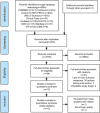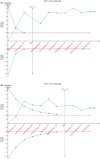A hypotensive protocol of inspiratory muscle strength training: Systematic review and meta-analysis with trial sequential analysis
- PMID: 37803506
- PMCID: PMC10631095
- DOI: 10.1111/jch.14655
A hypotensive protocol of inspiratory muscle strength training: Systematic review and meta-analysis with trial sequential analysis
Abstract
The aim of this study was to evaluate the hypotensive effect and optimal protocol of inspiratory muscle resistance training (IMST). Randomized controlled trials using IMST to lower blood pressure (BP) were retrieved from 12 databases as of July 2022. A meta-analysis of BP and heart rate variability (HRV) was performed and a trial sequence analysis was performed using trial sequential analysis (TSA) software. Twelve articles (n = 386 participants) from five countries were included, with a mean quality score of 5.83. IMST achieved significant results in reducing systolic, diastolic, and mean arterial pressure (-7.93 [-12.08, -3.78]; -3.80 [-6.08, -1.53]; -4.90 [-13.76, 3.96]). Furthermore, TSA has shown that the findings for systolic and diastolic BP are conclusive. Finally, considerable variation remained between studies when analyzing HRV. The overall hypotensive effect of IMST was demonstrated by the TSA and was well tolerated in different populations. Of these, two interventions, high resistance or low resistance combined with slow breathing, showed the best efficacy under an 8-week exercise intervention. In addition, the process of lowering BP by modulating sympathetic vagal activity has not been further confirmed in this study. Future long-term interventions, especially those over 3 months, are needed to observe the prolonged antihypertensive effects and modulatory mechanisms; controlling for variables such as respiratory rate and executing more rigorous studies to further explore antihypertensive options.
Keywords: exercise protocol; hypertension; inspiratory muscle strength training; mechanism; meta-analysis.
© 2023 The Authors. The Journal of Clinical Hypertension published by Wiley Periodicals LLC.
Conflict of interest statement
The authors declare no conflict of interest.
Figures





Similar articles
-
A multi-trial, retrospective analysis of the antihypertensive effects of high-resistance, low-volume inspiratory muscle strength training.J Appl Physiol (1985). 2022 Oct 1;133(4):1001-1010. doi: 10.1152/japplphysiol.00425.2022. Epub 2022 Sep 15. J Appl Physiol (1985). 2022. PMID: 36107991 Free PMC article. Clinical Trial.
-
Inspiratory muscle strength training lowers blood pressure and sympathetic activity in older adults with OSA: a randomized controlled pilot trial.J Appl Physiol (1985). 2020 Sep 1;129(3):449-458. doi: 10.1152/japplphysiol.00024.2020. Epub 2020 Jul 30. J Appl Physiol (1985). 2020. PMID: 32730174 Free PMC article. Clinical Trial.
-
Acute cardiovascular responses to a single bout of high intensity inspiratory muscle strength training in healthy young adults.J Appl Physiol (1985). 2021 Apr 1;130(4):1114-1121. doi: 10.1152/japplphysiol.01015.2020. Epub 2021 Feb 18. J Appl Physiol (1985). 2021. PMID: 33600284
-
Respiratory muscle training in children and adults with neuromuscular disease.Cochrane Database Syst Rev. 2019 Sep 5;9(9):CD011711. doi: 10.1002/14651858.CD011711.pub2. Cochrane Database Syst Rev. 2019. PMID: 31487757 Free PMC article.
-
Exercise training undertaken by people within 12 months of lung resection for non-small cell lung cancer.Cochrane Database Syst Rev. 2019 Jun 17;6(6):CD009955. doi: 10.1002/14651858.CD009955.pub3. Cochrane Database Syst Rev. 2019. PMID: 31204439 Free PMC article.
References
-
- Hanssen H, Boardman H, Deiseroth A, et al. Personalized exercise prescription in the prevention and treatment of arterial hypertension: a Consensus Document from the European Association of Preventive Cardiology (EAPC) and the ESC Council on Hypertension. Eur J Prev Cardiol. 2022;29(1):205‐215. - PubMed
-
- Emrich IE, Böhm M, Mahfoud F. The 2018 ESC/ESH Guidelines for the management of arterial hypertension: a German point of view. Eur Heart J. 2019;40(23):1830‐1831. - PubMed
-
- Whelton PK, Carey RM, Aronow WS, et al. 2017 ACC/AHA/AAPA/ABC/ACPM/AGS/APhA/ASH/ASPC/NMA/PCNA Guideline for the Prevention, Detection, Evaluation, and Management of High Blood Pressure in Adults: executive Summary: a Report of the American College of Cardiology/American Heart Association Task Force on Clinical Practice Guidelines. Circulation. 2018;138(17):e426‐e483. - PubMed
-
- Noone C, Leahy J, Morrissey EC, et al. Comparative efficacy of exercise and anti‐hypertensive pharmacological interventions in reducing blood pressure in people with hypertension: a network meta‐analysis. Eur J Prev Cardiol. 2020;27(3):247‐255. - PubMed
-
- Rodrigues F, Araujo AA, Mostarda CT, et al. Autonomic changes in young smokers: acute effects of inspiratory exercise. Clin Auton Res. 2013;23(4):201‐207. - PubMed
Publication types
MeSH terms
Substances
Grants and funding
LinkOut - more resources
Full Text Sources
Research Materials

